This post is also available in:  Deutsch (German)
Deutsch (German)
Are you a fan of Nelson Mandela? Do you know what he fought for and what he suffered for his conviction? The Nelson Mandela Capture Site in KwaZulu-Natal not only provides information about the great statesman, but also an extraordinary sculpture makes a visit to the memorial site an unforgettable experience.
Since we spontaneously went to KwaZulu-Natal last year, we were not at all prepared for what we could visit there. While leafing through the tourist information, I came across information about the Nelson Mandela Capture Site in the Midlands of the province. I was fascinated by the photo of the sculpture on display there, so we headed towards Howick, and from there a few kilometres further on the R103 to the memorial site.
What happened at this place?
On 5 August 1962, Nelson Mandela drove from Durban to Johannesburg on the R103 in the disguise of the chauffeur of Cecil Williams, a communist activist.
By that time, he had already been in hiding for 17 months. Shortly before, he had visited Albert Luthuli, the president of the ANC, in Groutville, to report on his trip to other African countries where he had asked for support for armed resistance against the apartheid regime.
The police had received a tip that Mandela was driving on the R103. Near Howick, they stopped the car and arrested Nelson Mandela.
Mandela was later charged with treason in the Rivonia Treason Trial and sentenced to life imprisonment.
Thus, he disappeared from the world for 27 years, most of which he was incarcerated in prison on Robben Island. Nevertheless, his arrest led to an awareness of the unjust conditions and oppression of the black population in South Africa and abroad. “Free Nelson Mandela!” became the battle cry of the anti-apartheid movement.
The history of the Nelson Mandela Capture Site
The artist Marco Cianfanelli and the architect Jeremy Rose worked together from 2007 to 2012 to create a unique monument dedicated to the life of Nelson Mandela.
Exactly 50 years after Mandela’s arrest, on August 5, 2012, the Nelson Mandela Capture Site was inaugurated by then-President Jacob Zuma.
A small museum opened on the site in 2016. The museum is a branch of the Apartheid Museum in Johannesburg and was established in cooperation with the government of the province of KwaZulu-Natal.
Today the site is one of the most visited tourist attractions in KwaZulu-Natal.
The museum at the Nelson Mandela Capture Site
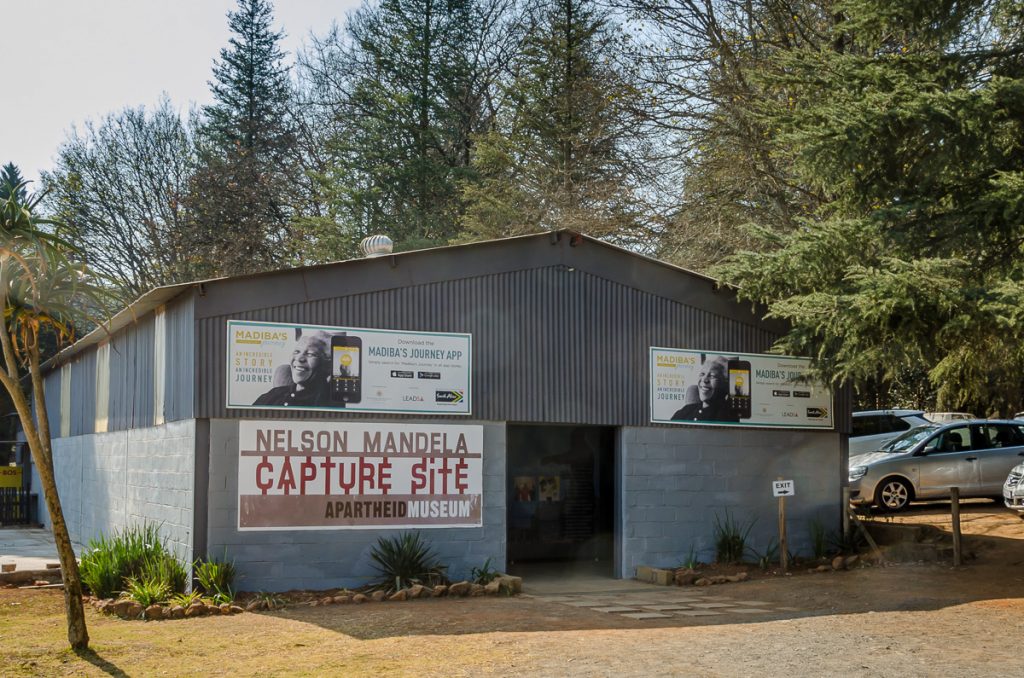
We drove to the capture site and saw from afar the columns that make up the sculpture, but from the perspective of the road, they are simply columns standing around in the landscape.
We parked in the parking lot under some shady trees. The site was well visited. Many cars but also tourist buses were standing around.
First, we inquired about an entrance fee. Access to the site is free, but we could donate money to maintain the facility.
We then went to a small museum that is housed in a tin shed. It is a good thing that the museum is at the entrance, as we could interpret everything else on the memorial site much better in the light of the information.
The exhibition consists mainly of information panels with photos and text about the life of Nelson Mandela and the struggle against the apartheid regime. The focus of the exhibition is the capture of Mandela and the 27 years of his imprisonment.
Although the exhibition is quite modest, it is worth the effort to spend about an hour there.
I grew up as a white woman in South Africa. Nelson Mandela’s capture took place a few years before I was born. During my life in South Africa before 1994, despite political and historical interest and my resistance to the injustices of apartheid, I learned next to nothing about Nelson Mandela (who was called a “terrorist” by the white population) or about the anti-apartheid movement. The white government’s propaganda machine worked too well.
Of course, later, when the book came out, I had read “The Long Road to Freedom”. The book and the film “Invictus” made me a Madiba fan. But here, in the museum, I now saw pictures of events that also happened in the country where I had lived for many years. It made me angry and sad at the same time – not only about the terrible events that had happened but also about how we, the white citizens of the country, were shielded from these events.
The long walk to freedom
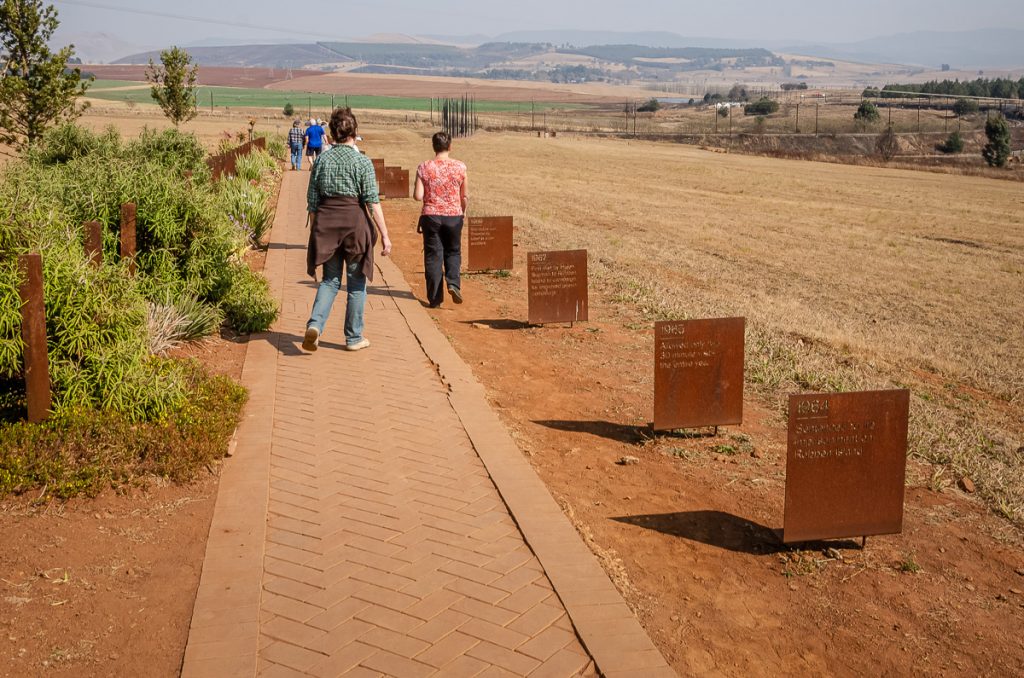
Next, we walked along a paved path of about 500 m length to the sculpture. At the side of the path were metal signs informing about the long way to freedom.
I took the time to read and reflect on the signs. Mandela was arrested before my birth. I now read what happened in the year of my birth and further on in the years after.
As in the museum, my life until 1990 seemed like that in a parallel universe. While we white people lived in a beautiful, intact world, privileged because of our skin colour, right next door and yet invisible to us, a merciless fight took place against all those in the population who wanted the same freedom as we did. Again, the path made me angry and sad at the same time – angry because apartheid existed in the country where I had lived, sad because so many, just because they were not white, were not allowed to experience the freedom and benefits I had.
The sculpture
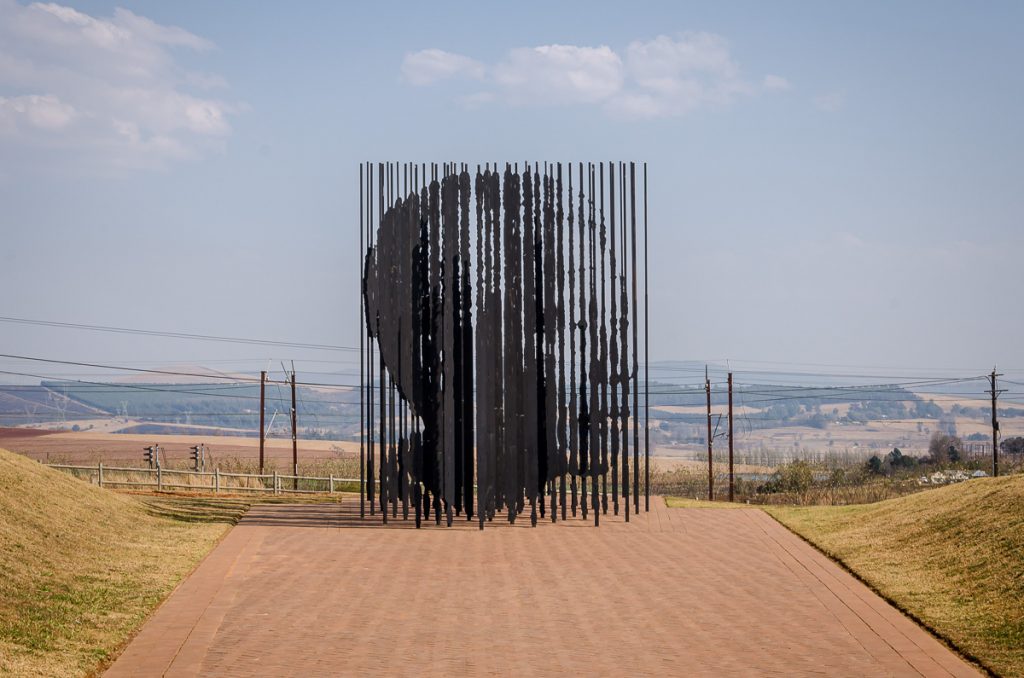
Already on the way, we could see from a distance the columns that make up the sculpture, but they were simply poles placed in a concrete floor.
Then, however, the image changed, and about 35 m in front of the sculpture, it became clear – from the three-dimensional steles a two-dimensional image of Nelson Mandela emerged.
The sculpture consists of 50 laser-cut steel columns, between 6.5 m and 9.5 m high. The collection of pillars has a diameter of about 30 m.
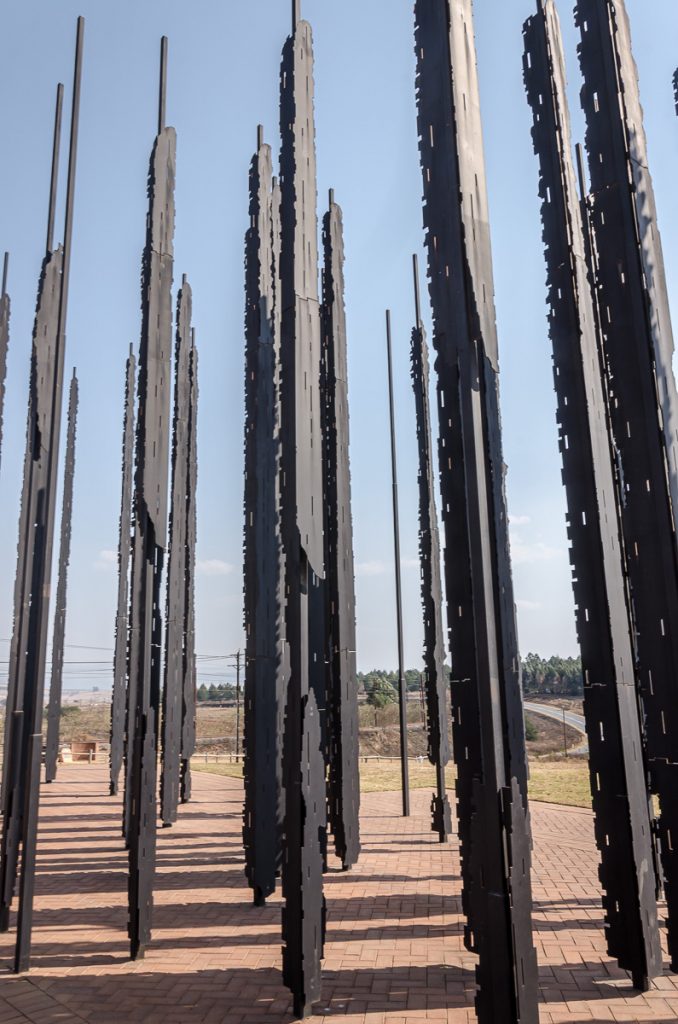
As we moved closer to the sculpture, the image of Mandela dissolved again, and the sculpture became a forest of steel columns.
The meaning of the sculpture at the Nelson Mandela Capture Site
The picture of Nelson Mandela, which suddenly appears at a distance of 35 m from the sculpture, shows how Madiba, after 27 years of captivity, suddenly became free again, visible in public.
Yes, for us who lived in southern Africa at the time, Mandela’s release was as unexpected as the fall of the Berlin Wall in Europe. Suddenly there he was – the man we only knew had been in prison for eternity. If anything, we only had seen pictures of him from the early 60s. Now there he was; an elderly gentleman, the later winner of the Nobel Prize for Peace (together with F.W. de Klerk, the white president who arranged his release), the later president of the Free Republic of South Africa.
Why 50 columns? Marco Cianfelli said to his artistic work:
“The 50 columns represent the 50 years since Nelson Mandela’s capture, but they also suggest the idea of the many making the whole: of solidarity. Mandela’s incarceration cemented his status as an icon of the struggle, which in turn helped ferment the groundswell of resistance.”
“The front of the sculpture is a portrait of Mandela, it has vertical bars which represent his imprisonment,” said Cianfanelli. “When you walk through the structure, it radiates like a burst of light, which symbolises the political uprising of many people and solidarity.”
It is therefore fitting that the sculpture was called “Release” by its creator. From the bars symbolising the prison, the image of Madiba emerges. But not only he but also the people he fought for, were released.
The real Capture Site
The sculpture stands a little away from the street where Nelson Mandela was captured on that August 5, 1962.
As we walked past the sculpture, we saw five more steles that form an axis to the place of capture on the street.
The way back
On the way back to the car, I thought about what I had experienced.
I miss Madiba. It was too short a time to get to know him.
But I am also glad – glad that his fight and that of his comrades-in-arms was successful. I am glad that apartheid is history.
I am glad that he became the first President of free South Africa and that he aimed to bring about reconciliation between people of all races. Revenge was alien to him, despite 27 years in prison and the injustice of the apartheid regime. His dream was a South Africa where everyone, no matter what colour of skin they are, could be free. He and his comrades-in-arms were able to realise this dream. Now it is up to Madiba’s successors and us to ensure that the dream remains a reality.
Further information
We were on the site in August 2019 and saw that another large building had been erected. At the moment a conference centre is being set up there. According to the official website, this Centre should have opened in November 2019. Unfortunately, I have not found any information about whether the opening has already taken place and to what extent the memorial has changed as a result.
There is a café on the premises, which is supposed to serve excellent coffee. There is also a small shop with handicrafts, a bookshop and a children’s playground. As a big tour bus had just let its passengers loose on the café and the shop, we did not visit the shops.
Conclusion
Is the site worth a visit?
Yes! In two ways:
- The work of art: the sculpture is truly unique and worth seeing.
- The confrontation with history: it is important to know the history, because how did George Santayana say?
“Those who cannot remember the past are condemned to repeat it.”
George Santayana
So, if you drive through the Midlands of KwaZulu-Natal and pass the Nelson Mandela Capture Site, stop, go to the museum, walk the long way down to the sculpture and then look at the picture of Nelson Mandela.
If I may give you a further tip: Before your visit, read the autobiography Nelson Mandela – The Long Road to Freedom.
Bibliography
Armstrong, Desmond: Mandela Capture Site | Battlefields Route. Battlefields Route KwaZulu-Natal. Available online at https://www.battlefieldsroute.co.za/place/mandela-capture-site/.
Cabs, Rikki (2017): Nelson Mandela Capture Site – Howick KZN. Rikki Cabs. Available online at https://www.rikkicabs.co.za/nelson-mandela-capture-site/.
Glanville, Darren: Nelson Mandela Capture Site – Howick, South Africa – Atlas Obscura. Atlas Obscura. Available online at https://www.atlasobscura.com/places/nelson-mandela-capture-site.
Mandela, Nelson (1994): Long walk to freedom. The autobiography of Nelson Mandela. 1. ed. Boston: Little Brown.
Maughan-Brown, Paul (2015): Life just off the road: a guide to Howick – Getaway Magazine. Getwaway. Available online at http://www.getaway.co.za/travel-news/guide-to-howick/.
Unknown: Face of Freedom. Condé Nast. Available online at http://www.cntraveller.com/gallery/nelson-mandela-sculpture-tourist-guide.
Unknown: Nelson Mandela Capture Site | Tourist Attraction. Apartheid Museum. Available online at https://www.thecapturesite.co.za.
Unknown: Nelson Mandela Capture Site Sculpture – The Inspiration Room. Inspiration Room. Available online at http://theinspirationroom.com/daily/2013/nelson-mandela-capture-site-sculpture/.
Unknown: The Capture Site – The Midlands Meander KwaZulu-Natal. Midlands Meander. Available online at https://midlandsmeander.co.za/item/the-capture-site/.
Unknown: The Nelson Mandela Capture Site – Howick. In Africa and Beyond. Available online at https://inafricaandbeyond.com/nelson-mandela-capture-site-howick/.
Unknown (2012): Unique sculpture at Mandela Capture Site. Brand South Africa. Available online at https://www.brandsouthafrica.com/people-culture/mandela/capture-site-open.
Unknown (2014): 5 Important facts about the Nelson Mandela Capture Site – Review. Review Available online at https://reviewonline.co.za/54815/5-important-facts-nelson-mandela-capture-site/.
Unknown (2015): Nelson Mandela’s Capture Site. Mrs D does Africa Part 5 (Mrs. D plus 3). Available online at http://www.mrsdplus3.com/travel-2/nelson-mandelas-capture-site/.
Unknown (2018): Mandela Capture Site | South African History Online. South African History Online. Available online at https://www.sahistory.org.za/place/mandela-capture-site.
Unknown (2019): Midlands Meander & Mandela’s Capture Site. Cedarberg Africa. Available online at https://www.cedarberg-travel.com/experiences/midlands-meander-mandelas-capture-site/.

Anette Seiler
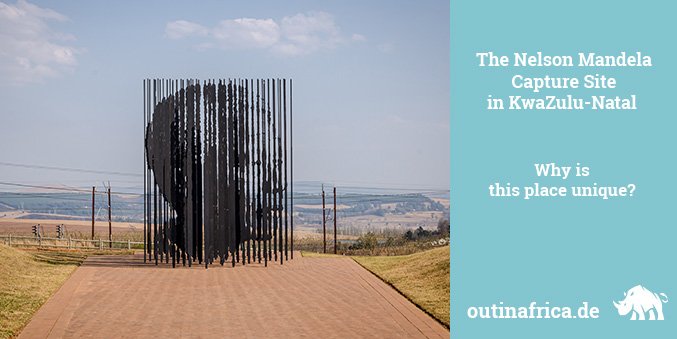
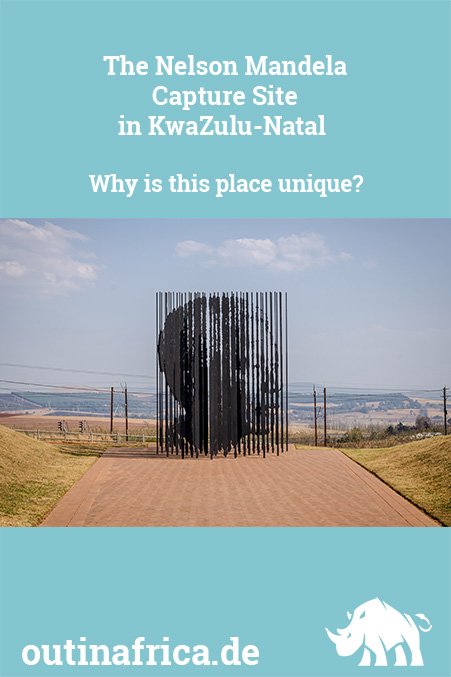

Leave a Reply